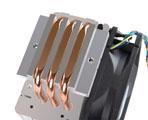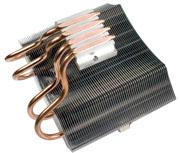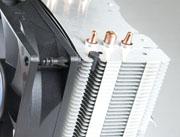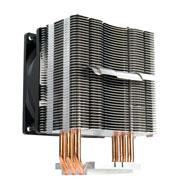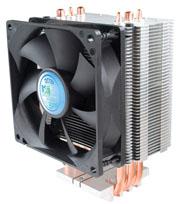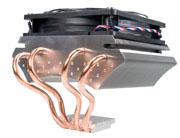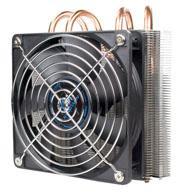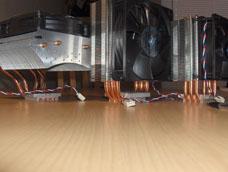|
Kingwin RVT-9225, RVT-12025, and RVT-12025D CPU Coolers

A Closer Look:
Lets start with what the Kingwin coolers all have in common, their base technology. As you can see from the pictures, the heat pipes are well exposed, and have a lot of surface contact with the processor itself. The thing I don't like is that the surface that is in contact with the processor is not perfectly smooth. You can see, there is a small gap where the round heat pipe was flattened to be flush with the heat block, but there are gaps on the edges, where there will be stale air trapped. It might just be a personal preference, but I have been trained (my reading reviews and cooling information sites and the like) that the surface touching the processor should be perfectly flat. No bumps, or grooves, or anything. These gaps sure count as grooves. But maybe that doesn't actually make a difference. We will see in the testing phase. In theory the elimination of bumps, scratches, and grooves leads to more surface area coming into contact with the CPU IHS (Integrated Heat Shield) and thus better thermal transfer. While practice does show that a smoother surface does account for better heat transfer, in reality the performance difference may only be a matter of a few degrees. if any of you are into overclocking you will agree that every degree counts and that you want this surface to be mirror smooth and as flat as possible. Imagine if one side or corner was slightly raised or if there was as small as a grain of sand placed in the center of the CPU interface. This small flaw could raise the entire interface off the CPU and account for a large increase in temperature, even possibly enough to fry your CPU. I bet you want that surface smooth now, don't you?
Looking again at the Kingwin cooler in question we see that while the edges are not flat the center area is and does account for more than the surface area of the CPU's which it is meant for. The gap we question is the gap between the mating edges of the aluminum block and copper heatpipes sandwiched between. We will test this cooler and see if this gap could lead to unacceptable temperatures.
Click on the thumbnails to enlarge.
Coming up from the base, the heat pipes travel through a rather large heat sink. The only difference between the different models is the size and shape of the heat sink. The RVT-9225 and the RVT-12025 both are upright (as in, perpendicular to the motherboard) rectangular blocks with a fan mounted on one side. Both of those coolers have three heat pipes. These two coolers actually look exactly the same: Kingwin just looked at their first one, and said "New Size = Old Size x 2," and that's how they created the RVT-12025. The RVT-12025D is an entirely different cooler though. Instead of standing upright, perpendicular to the motherboard, this one is squat, and sits parallel to it. The fan is mounted on top and blows air directly down, thought the heat sink, onto the heat block sitting on the processor. I like this concept a little better, both because the heat sink looks a lot more attractive, and because, at least in theory, this would seem smarter. The air being blown around isn't passed through the heat sink and forgotten about. It also hits the heat block, adding another minor cooling method. I have no idea if this is actually the thought processes behind it, or if this is even how it would work, but in theory it seems smart. The only down side is that you are unable to navigate the warm air conveniently out of the case right away. It simply splashes against the mainboard and then has to be taken care of by your case's air flow with case fans. I guess we will see which method of Kingwin's actually works better.
RVT-9225 and RVT-12025
Click on the thumbnails to enlarge.
RVT-12025D
Click on the thumbnails to enlarge.
Installation
I was installing these coolers on an Intel Socket 775 motherboard, so I had to use those annoying push-pins. I don't know if anyone else has any issues with those things, but I have ALWAYS had to struggle to get all four pushed down and staying down. They seem to want to pop back up, and I feel like I am either going to crack my motherboard or lose my heatsink during usage. Anyway, installation was the same for these coolers as any other, for the most part. The RVT-9225 was the easiest to get to the stupid pins, because it has the smallest heat sink, allowing for more room for my fingers to navigate down towards the mainboard. The RVT-12025 wasn't much more difficult, since it is only slightly wider. The nice thing about these coolers is that they all have a decent amount of room for your fingers between the heatsink and the motherboard itself, making them easier to install than some other cpu coolers I have had to review (cough Ninja cough). The hardest to install out of these three was the RVT-12025D, though. It's heat sink is massive, very wide. Installation of it was fairly easy for me, but then, my case has a removable motherboard tray, so I am just speculating how difficult it would be if you had to have it mounted inside your case. All in all, it was a straight forward install, and if you have any familiarity with installing a CPU cooler, the Kingwin coolers will be no more difficult for you then any other.
The clearance underneath the fins of each of the three coolers.
Click on the thumbnail to enlarge.
| « Introduction and Specifications | The Test Drive » |





